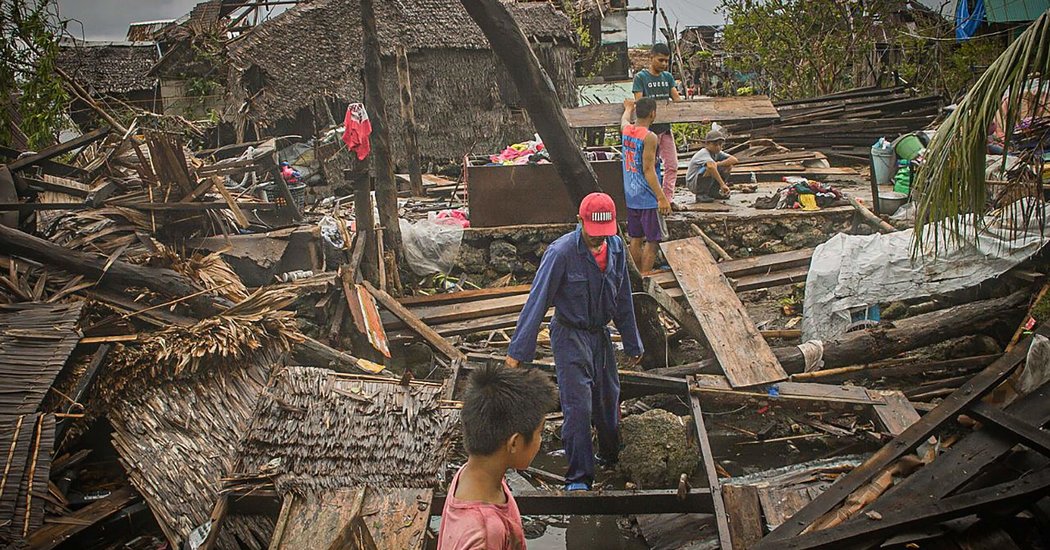MANILA — Tens of thousands of people fled to evacuation centers on Friday as Typhoon Vongfong barreled toward the Philippines’ main island of Luzon, dumping torrential rains and raising fears that the coronavirus could spread in packed evacuation centers.
One death was reported in Eastern Samar Province as the typhoon, the first to hit the country this season, brought heavy winds and rain, destroying hundreds of buildings as well as crops and fishing boats.
Luzon, home to about 60 million people, has been on an extended lockdown to prevent the spread of the coronavirus. But with evacuation centers now packed, officials worry that they will become breeding grounds for the further spread of the virus. Officials said more than 50,000 people had taken refuge in the centers.
The typhoon, as strong as a Category 3 hurricane, made landfall in the Philippines by slamming into the eastern island of Samar on Thursday afternoon. By Friday morning, it was wreaking havoc over the island of Masbate and parts of Quezon Province on the southern tip of Luzon.
The Office of Civil Defense in Manila, the capital, which is in Luzon, warned residents living along coastal areas of storm surges of up to six feet along the Philippine islands’ eastern coasts. Moderate to heavy rains were expected for the rest of the day over the Bicol region to the east, as well as Metro Manila and the provinces of Rizal, Quezon, Aurora, Laguna, Bulacan, Nueva Vizcaya and Quirino.
By midafternoon Friday, the typhoon had weakened as it wound its way up Luzon, with estimated maximum sustained winds of nearly 70 miles per hour. It was expected to bring heavy showers over Luzon’s eastern seaboard.
Images on Twitter showed tin roofs and trees being blown away. The storm also knocked out electricity and communication lines in large parts of the affected regions.
Mark Timbal, a spokesman for the Office of Civil Defense in Manila, said that local officials in areas in the path of the storm were urged to make sure that people taking refuge in evacuation centers were observing social distancing protocols.
“It is a unique situation because it is the first time that we’re going to face a natural hazard like a storm while taking into consideration a pandemic situation,” he said.
Shiewin Taay, mayor of the town of Dingalan in Aurora Province in eastern Luzon, said on local radio that at least 3,000 families living in disaster-prone areas had been evacuated. He described the situation as a “nightmare scenario.”
He said the usual evacuation centers had been turned into quarantine facilities to handle Covid-19 cases, so local agencies were using schools as temporary shelters.
More than 2,000 families had fled to evacuation centers in the central province of Northern Samar, according to the regional police.
In the Taft municipality in Eastern Samar Province, the disaster risk and reduction management officer, Rhoda Cosipag Barris, said there were no local reports of casualties, but farming and fishing had been devastated.
“We are appealing for help,” she said. “Our farmers have been greatly affected because their vegetable plantations and other agricultural products — the major source of their livelihood — have been literally uprooted and destroyed due to the strong winds brought about by the typhoon.” She added that fishing boats had been washed away.
Fernando Hicap, head of Pamalakaya, a group representing fishermen, said the typhoon had displaced many fishermen and farmers along the coasts of Samar, southern Luzon and the Bicol region further to the east.
He appealed to the authorities to provide personal protective equipment to evacuated families because the centers housing them could become hotbeds for the spread of infection.
“Local and national governments must be prepared in providing assistance to the affected families to ensure that the natural calamity will not worsen the socio-economic impacts of the pandemic,” he said.
At least 20 typhoons hit the Philippines every year, some of them deadly. In 2013, Super Typhoon Haiyan slammed into the central Philippines, carving a wide swathe of destruction across the country and leaving 6,000 dead.















